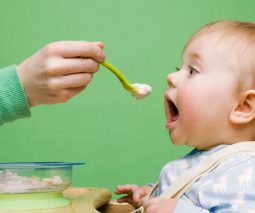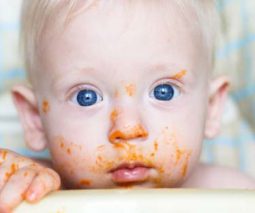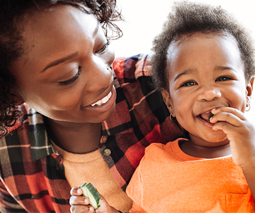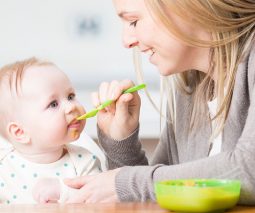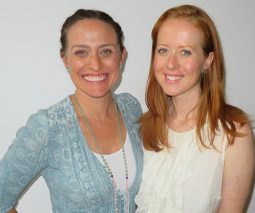Guide to baby’s first foods: what foods to introduce and when
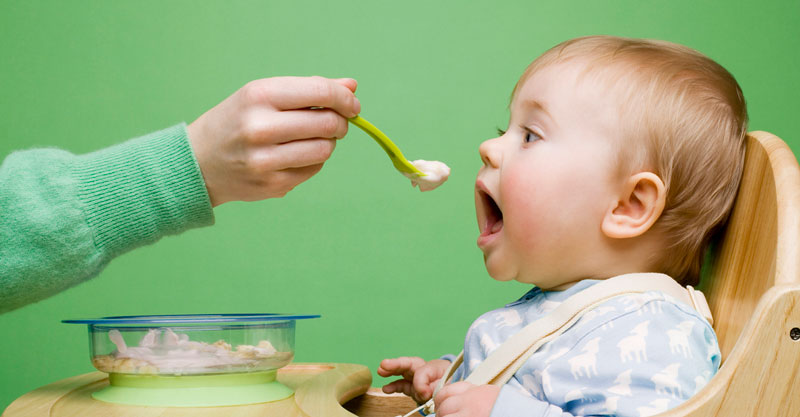
The day your baby tastes her first spoonful of mush and shoots you a ‘what the heck was that?!’ look, is a momentous occasion. Starting solid food is a journey of discovery and one that is filled with wonder, excitement and, sorry to say, mess!
If you think your bub may be ready to delve into this brave new culinary world, but you’re feeling a little overwhelmed by all the ‘advice’ out there, this simple guide to when to start and what sort of foods to give her will help.
Is my baby ready to start eating solid foods?
The first thing you need to do is to look for the signs that your little one is ready to start on solid foods.
Most babies will show these signs at around six months old. This is also the time her iron stores run low and she needs extra food for her growth and development.
Look for these solid-food-readiness signs in your six-month-old:
- An increased appetite.
- Shows an interest in food.
- Can sit upright with limited support and can control her head and neck.
- Tries to reach out for your food.
- Opens her mouth when you offer her food on a spoon.
Note: it is strongly recommended that solids are NOT introduced before four months of age, as a baby’s system is too immature.

Food before or after a milk feed?
When starting solids, your baby will still need her breast of formula feed first up. This is because when babies are really hungry, all they want is what they know satisfies their hunger – and that means milk! She’ll still have room to try new foods after her breast or bottle feed.
How to start?
Try not to overthink it. Starting solids shouldn’t stress you or your baby out. As a general rule though, starting small and progressing onto more adventurous tastes and new textures when your baby is ready to try them is the way to go. You don’t have to introduce foods in any particular order, this is just a general guide so if you want to introduce tofu at 7 months instead of 8 as listed here, then go ahead!
You can mix first foods together – there’s no need to introduce just one food at a time – but doing so can help with identifying allergic reactions if you have a family history.
From six months: start smooth
When it comes to first foods, it’s not so much about the type of food you give but its texture. As long as the food is rich in iron and of a smooth consistency, your baby will love it.
Good first foods to try include:
- liquid consistency iron-rich baby cereal mixed with either breast milk, formula or water
- cooked and pureed vegetables such as pumpkin, potato, sweet potato or zucchini
- smooth, cooked apple, pear and peaches
- cooked pureed liver and meat
Six to eight months: progress from purees to lumpier textures
Once your baby has gotten used to having a spoonful of pureed this or that in her mouth and is taking to solids, you can venture into more lumpy textures over time.
This could include:
- pureed and then strained soft vegetables
- mashed potato, pumpkin and sweet potato
- minced or finely shredded cooked meat, chicken and eggs (not raw or runny)
- any mashed or soft cooked vegetables, including beans, lentils and broccoli
- cooked and mashed fruit
- cooked and mashed or minced boneless fish
- chipped soft raw fruit such as melon and banana
- cereals such as rice, wheat, oats and mashed pasta and noodles
- blended tofu
- pureed or mashed cooked legumes (black beans, chickpeas, edamame, fava beans, black-eyed peas, lentils, kidney beans)
- porridge (oats)

Eight to 12 months: start introducing finger foods
By now your little eater will be loving meal times and so it’s the time to really have fun with recipes and giving her a variety of foods. In addition to all the foods listed above you may want to try giving her:
- small amounts of soft pasteurised cheese such as cottage cheese
- unsweetened , natural yogurt (while you can’t give cow’s milk to drink until age one, full fat yoghurt is OK)
- mashed vegetables (cooked carrots, squash, potatoes, sweet potatoes)
- mashed fruits (bananas, peaches, pears, avocados)
- custard
Once your baby has mastered lumpy foods, you can break out the finger foods and let her practice her pincer grip. Scatter some food on her highchair tray and watch her go to town.
Finger food ideas include:
- cooked green beans, soft carrot sticks, cooked broccoli trees, zucchini sticks and other vegetables
- soft fruits such as banana, melon and crushed blueberries
- avocado slices
- pasta she can grasp such as spirals
- a sandwich cut into quarters
- tofu slices
- cut up soft raw and cooked fruit
- small bits cooked meat or shredded poultry
- small bits of scrambled eggs
- pieces of cooked potato, pumpkin
- small bits of boneless fish
- well-cooked beans, like lentils, split peas, pintos, or black beans
- iron-fortified cereal (barley, wheat, oats, mixed cereals)
From 12 months onward: all in!
Your baby can enjoy all family foods by the time she is 12 months old, excluding low-fat dairy and obvious choking hazards such as whole nuts. Honey and cow’s milk, goat’s milk and soy milk can be introduced at her first birthday.
A note on allergies
Once upon a time parents were advised to avoid allergenic solid foods including peanut butter, cooked egg, dairy and wheat products in the first year of life. The Australasian Society of Clinical Immunology and Allergy (ASCIA) infant feeding guidelines now advises that all babies, including babies with a high allergy risk, are exposed to these in the first year. The thinking now is that introducing these foods can actually protect your baby against developing an allergy. Read more about the new allergy recommendations here.




